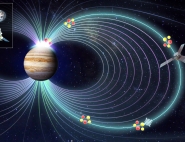CNES projects library
C
I
M
P
S
U
Bi
Xmm-Newton
X-rays are emitted by the hottest known sources such as stars, hot interstellar gases, black holes, galaxies and galaxy clusters. The cameras on the XMM-Newton satellite (for X-ray Multi-Mirror) are the most sensitive yet built to detect them and its mirrors are among the most powerful ever developed for X-rays.
XMM-Newton was launched on 10 December 1999 from Kourou by an Ariane 5 vehicle. It is still operating today, circling Earth in a 48-hour, 40°-inclined elliptical orbit at a distance of 114,000 km at its furthest point and 7,000 km at its closest.
XMM-Newton is the 2nd cornerstone mission of the European Space Agency’s Horizon 2000 programme. With support from CNES, research laboratories at the CEA (Commissariat à l’énergie atomique et aux énergies alternatives) and the IAS (Institut d'Astrophysique spatiale) contributed to the satellite’s EPIC instrument, while IRAP (Institut de Recherche en Astrophysique et Planétologie) developed its ERMS instrument. The Strasbourg Observatory, the CEA’s Saclay facility and IRAP are also playing an active role in the XMM-Newton Survey Science Centre (SSC) that conducts systematic analysis of observations. Some 2,000 astronomers around the world use XMM-Newton data.
Mission's news feed
-

XMM-Newton sees light echo from behind a black hole
For the first time, astronomers have singled out light coming from behind a black hole, enabling them to study the processes on its far side.
July 28, 2021
-

The mystery of what causes Jupiter’s X-ray auroras is solved
The 40-year-old mystery of what causes Jupiter’s X-ray auroras has been solved. For the first time, astronomers have seen the entire mechanism at work – and it could be a process...
July 9, 2021
-

XMM-Newton spies youngest baby pulsar ever discovered
An observation campaign led by ESA’s XMM-Newton space observatory reveals the youngest pulsar ever seen that is also a ‘magnetar’, sporting a magnetic field some 70 quadrillion...
June 17, 2020


